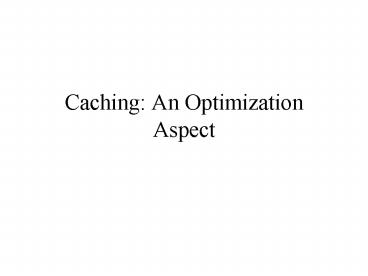Caching: An Optimization Aspect - PowerPoint PPT Presentation
Title:
Caching: An Optimization Aspect
Description:
Cache the value of the sum for each container and the number of violations. If the same container is checked again and there has been no change, we can ... – PowerPoint PPT presentation
Number of Views:20
Avg rating:3.0/5.0
Title: Caching: An Optimization Aspect
1
Caching An Optimization Aspect
2
Part 1a
- Background Container/Simple both inherit from
Item Container contains vector of Item. - Cache the value of the sum for each container and
the number of violations. - If the same container is checked again and there
has been no change, we can reuse the cached values
3
HashTable method
- Hashtable cachenew Hashtable()
- pointcut changed(Container c)target(c)
- call( Container.addItem(..))
- before(Container c)changed(c)
if(cache.containsKey(c)) - Container containc.getContainer()
- cache.remove(c) //invalidate
- while(contain!null) cache.remove(contain)
containcontain.getContainer()
4
- pointcut getvalue(Item i)target(i)
- call( .check(..))
- int around(Item i)getvalue(i)
if(cache.containsKey(i)) - return ((Integer)cache.get(i)).intValue() int
vthisJoinPoint.proceed(i) cache.put(i,new
Integer(v)) - return v
5
Introductions
- private int Container.violations 0
- private int Container.total 0
- private boolean
- Container.cacheIsValid false
6
- pointcut getTotal(Container c)
- call (int check(..)) target(c)
- int around (Container c) getTotal(c)
- if(c.cacheIsValid)
- System.out.println(c.name " using cached
value for total " c.total) - if(c.violations gt 0)
- System.out.println(c.name " had "
c.violations " violations") - return c.total
- else return proceed(c)
7
- after(Container c) returning (int tot)
getTotal(c) - c.total tot
- c.violations c.total - c.capacity
- c.cacheIsValid true
8
Adding a new item
- pointcut newItem(Container c, Item i)
call(void setContainer(..)) - target(i) args(c)
- after(Container c, Item i) newItem(c, i)
- c.setValid(false)
- public void Container.setValid(boolean
isValid) cacheIsValid isValid - if(getContainer() ! null)
- getContainer().setValid(isValid)
9
What was learned?
- The Hashtable allows us to better encapsulate the
Caching aspect, leaving us with more elegant code
that doesnt pollute the name-space of Container - It seems cleaner for each Container to keep track
of its total weight. This will also probably
shorten the run-time.
10
Part 1b/d Improving modularity and reusability
- If we dont cache, we dont need the back
pointers in our containers. So make it an aspect! - Improve reusability through use of abstract
aspects.
11
Back pointer based on introductions
- private Container Item.container
- public void Item.setContainer(Container c)
- container c
- public Container Item.getContainer()
- return container
12
Setting the BP
- pointcut addingItem(Container c, Item i)
call (void addItem(..)) - target(c) args(i)
- after(Container c, Item i) addingItem(c, i)
- i.setContainer(c)
13
Abstract Caching Aspect
- There is a Parent/Child relationship which can be
useful in creating abstract aspects. - interface Parent extends Child
- void addItem(Child c)
- abstract aspect Cashing
- abstract pointcut invalidate(Parent p)
- abstract pointcut cashing(Parent p)
14
- Such that we can implement interesting
functionality based - only on knowledge that a Parent/Child
relationship exists. - after(Parent p) invalidate(p)
- while(p ! null)
- beforeInvalidate(p)
- p.cashedValue -1
- p ((Child)p).getParent(
)































